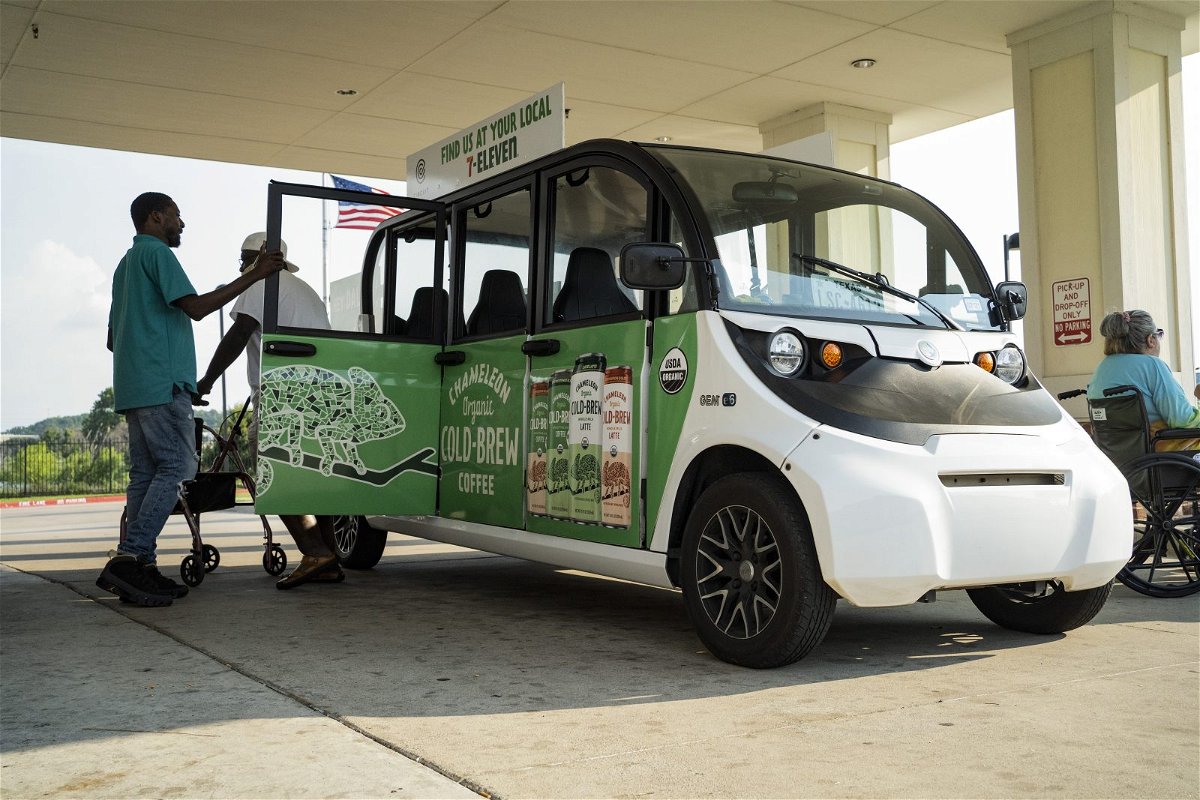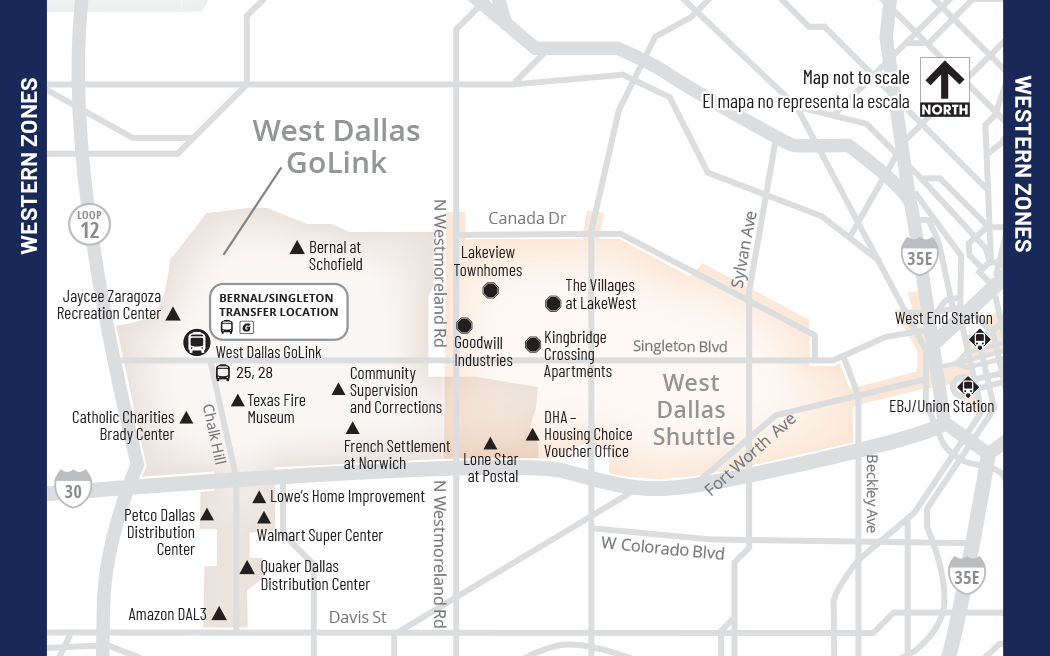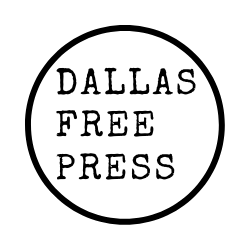
Each month more than 5,000 people use DART’s on-demand ride services, Circuit and GoLink, to travel between their West Dallas homes and their workplaces, the grocery store, a school, or a bus stop or train station.
Riders in West Dallas have options — free Circuit rides on the east side of the neighborhood, and $2.50 one-way GoLink rides on the west side.
Circuit: 4,000 West Dallas riders per month costs $635,000 per year
You can spot the small electric Circuit vehicles throughout the day, transporting neighbors free of charge. Its West Dallas program — the only one in the city — began in September 2020 and in 2023 served an average of 4,000 riders per month.
Circuit’s service area is bordered by Westmoreland, Canada Drive, I-30, and the Trinity River, and takes West Dallas riders across the river to DART’s West End and Union Station transit hubs.

DART began partnering with Circuit and Toyota last year as a one-year pilot program, and the DART board extended the partnership through the end of 2024.
In other cities with Circuit routes, fares are sponsored by major advertisers, a model which was intended to be for short runs and special events, according to co-founder Alexander Esposito. But in West Dallas, Circuit’s partnerships with Toyota and now DART have allowed it to run consistently over the past three and a half years.
In total, the program costs about $635,000 to operate annually, of which Toyota pays $315,000, Circuit pays $100,000, and DART contributes the remaining $220,000.
Aunquette Lockhart, a West Dallas neighbor and Circuit driver, says she’s greatly enjoyed her three months with the company, and feels she’s making a positive impact on the neighborhood.
“[My favorite part is] getting to meet people in the community,” Lockhart says. “It’s free to the community, and it helps because a lot of people struggle. It makes me feel good to help them by picking them up and taking them where they need to go.”
Why Toyota Foundation invested in Circuit as a transportation solution
Toyota’s interest in the program is connected to other projects they fund in West Dallas, such as the West Dallas STEM School. Toyota Driving Possibilities consultant Kelli Gregory says they’ve been happy to see the program succeed.
“I think the biggest success here is how this project with Circuit has not only been embraced by the community, but also by our partners,” Gregory says. “We’re really thrilled to serve needs that weren’t being served beforehand — getting kids to school, neighborhood trips for laundry, or getting to other DART stations.”
Currently there are six electric vehicles and over a dozen operators for West Dallas Circuit. Like Uber or Lyft, Circuit takes residents directly to their destination, operating through their app. Riders type in their pick up and drop off locations, and the estimated wait time pops up.
Two factors that set Circuit apart from other ride-sharing options are that the vehicles have a maximum speed of 35 miles per hour, and rather than using central air conditioning, they have tall open windows. For rainy days, this can make it hard to stay dry when using the service.
Additionally, the service runs only on weekdays, Monday through Friday from 7 a.m. to 7 p.m.
Esposito says that the main intention of Circuit is to assist with first and last mile trips, like helping neighbors get from their home to the best bus or rail stop, without long walks. In this way, Circuit can help riders better access DART, without an increased cost.
“We found that there’s a really big gap with getting people to and from these existing transit hubs, and it’s a lot easier to take the train or bus if you have a free or low cost way to get there,” Esposito says.
GoLink: 1,200 West Dallas riders per month costs $432,000 per year
A low-cost way for people to get to transit stations without a car is the reason DART launched the GoLink program in 2017, starting in the Dallas suburbs. Now, with 35 zones across its 700 square-mile service area, DART GoLink is “North America’s largest microtransit operation,” according to its partner Uber.
The West Dallas zone has a slight overlap with Circuit’s service area, but expands further west to Loop 12. DART launched the West Dallas zone in December 2021, two years after Circuit began operating in West Dallas.

DART staff said that, based on resident feedback, GoLink’s service area now includes the Amazon warehouse, Catholic Charities and other distribution centers along Chalk Hill, connecting West Dallas residents directly with their workplaces and services.
Though not free, GoLink is available for $2.50 per ride per passenger, with the same door-to-door service. GoLink rides are serviced either by a GoLink van or an Uber partner and are in more traditional vehicles that have air conditioning, closed windows and no maximum speed. GoLink also has more available hours, running from 5 a.m. to midnight seven days a week.
GoLink’s West Dallas service, which serves roughly 1,200 riders per month, costs DART approximately $432,000 annually. West Dallas is one of 35 DART GoLink zones across the metro area, and the average cost is $600,000 annually, with variations based on demand and slight size differences between the zones.
Rob Smith, vice president of service planning and scheduling, says GoLink has seen “explosive growth” in ridership since the end of the pandemic, only beginning to flatten out in recent months.
“The ridership that we see now is about 500% higher than it was before the pandemic, and year to year, the GoLink ridership has more than doubled,” Smith says. “That rapid growth, as the program really took off, has been the biggest thing that we’ve really noticed, and it’s happened all over the surface area, not just in one particular place.”
What does DART learn by having both programs?
While both services have consistent service, GoLink and Circuit in West Dallas, combined, are not yet as successful as the South Dallas GoLink zone, with more than 6,000 monthly riders. That zone has a population count similar to West Dallas but was rolled out differently, with community leaders pushing for the service.
Jing Xu, associate vice president for service planning and development, says both Circuit and GoLink have been cost-effective solutions and are regularly shifting boundaries to accommodate neighbors’ needs.
“Both programs are going strong and last year when we requested the pilot to be extended for one year, we did a specific analysis on how the West Dallas Circuit project may impact DART services,” Xu says. “It’s really supplementing DART services and providing the needed last-mile connections as well.”
DART and Circuit are currently working to see how Circuit’s services could be integrated into DART’s existing GoPass app, which would let DART customers see Circuit as an option in addition to its rail, bus and GoLink pricing and schedules.

Leave a Reply